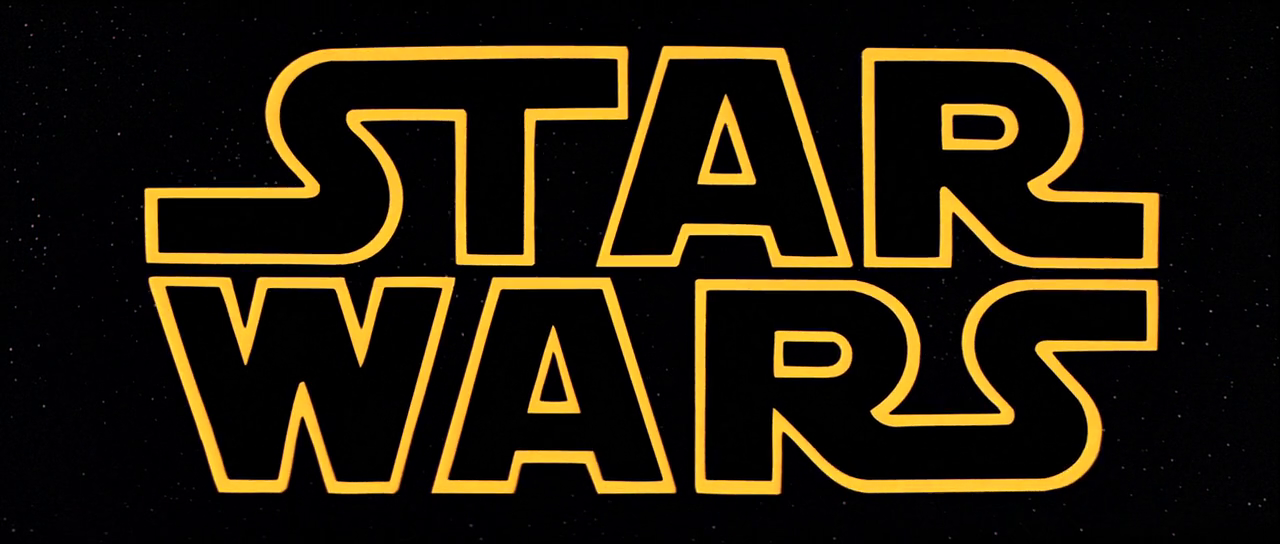
BUY FROM AMAZON: CLICK HERE!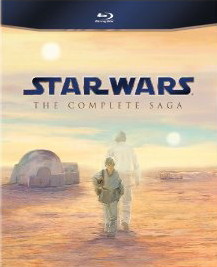
STUDIO: 20th Century Fox
MSRP: $139.99
RATED: PG/PG-13
RUNNING TIME: N/A
SPECIAL FEATURES:
- DVD Commentary from cast and crew on all 6 films
- Archival commentary on all 6 films
- Star Wars Archives: Deleted, extended and alternate scenes; prop, maquette and costume turnarounds; concept art; supplementary interviews with cast and crew; a fly-through of the Lucasfilm Archives and more
- The Star Wars Documentaries
–Star Warriors: A tribute to the 501st Legion
–A Conversation with the Masters: The Empire Strikes Back 30 Years Later
—Star Wars Spoofs
–The Making of Star Wars (1977)
—The Empire Strikes Back: SPFX (1980)
–Classic Creatures: Return of the Jedi (1983)
–Anatomy of a Dewback (1997)
–Star Wars Tech (2007)
The Pitch
“Hey Alan Ladd! It’s George! Your new director, George Lucas! You know that new sound you’re lookin’ for? Well, listen to this!”
The Humans: A few
The Aliens: A lot more
The Nutshell
Spanning a period of 40 years, tells the tale of Anakin Skywalker and his progeny, and how they respectively condemn and save a far away galaxy at war. Also, Muppets and shit.
The Lowdown
Ask Thom Yorke what OK Computer was meant to be about overall, and you’ll get a different answer depending on the hour and his current Britishness level, but the one I’ve heard that makes the most sense is this one, and apologies for not having the exact quote: Technology has made it easier for people to make what was once internal and subjective into external and collective, which isn’t bad by itself, but something is getting lost there. A person’s thoughts and feelings aren’t one’s own, but fed to us by others, regurgitated for general use.
In theory, this should bring us together as people. For some it does. For some it doesn’t, which is why we still shoot people in the head for disagreeing about which long-haired bearded hippie to believe in. For a lot of others, even on a subconscious level, as opposed to feeling connected to humanity, it’s just cause to feel indescribably sad and lonely.
That’s a particularly pretentious way to start a review for a series that doesn’t even get an hour in without a giant underwater trash monster showing up, I realize, but shush it, I’ve got a point. And that point is this: Star Wars hasn’t really been a personal experience for anyone in a very, very long time. When a franchise is this entrenched in the collective conscious, it’s near impossible, which is part of the reason talking about Star Wars gets so tired so easily. There’s a couple of variations on a collective Star Wars, none of those films are on a disc or tape anywhere, and for reasons beyond my comprehension, all of them seem to just bring out the worst in people, and that was even before 1997.
With that in mind, I can’t promise this review is the last unbiased word on this series. No pop culture occurs in a bubble, and to try and pretend otherwise especially when talking about the greatest shared experience of the modern age is a fool’s errand. And yet, to quote a great moustache, as God is my witness, I am that fool.
So, preamble aside, I’m going to review Star Wars now. All of it.
And to start off, I’d like to say fuck you.
Yes, you.
Fuck you. Fuck your rage. Fuck your disappointment. Fuck your damning with faint praise. Fuck your fake apathy. Fuck your condescension. Fuck your raped childhood. Fuck your cancelled pre-orders. Fuck your non-existent boycott. Fuck your petitions. Fuck your blind optimism. Fuck your faith. Fuck your denial. Fuck your obsessive compulsion. Fuck your guilty purchase. Fuck your non-anamorphic laserdiscs. Fuck Red Letter Media. Fuck Patton Oswalt. Fuck Brian Posehn. Fuck Seth McFarlane. Fuck Seth Green. Fuck Kevin Smith. Fuck Ernest Cline. Fuck Kevin Rubio. Fuck Joe Nussbaum. Fuck Alexandre Philippe. Fuck Tony Pacitti. Fuck Timyodie. Fuck Charles Ross. Fuck Ghyslain Raza. Fuck Timothy Zahn. Fuck Splinter of the Mind’s Eye. Fuck The New Jedi Order. Fuck Caravan of Courage. Fuck Battle For Endor. Fuck Droids. Fuck the Holiday Special. Fuck Beneath The Dome. Fuck TheForce.net. Fuck the Ain’t It Cool Talkbacks. Fuck the 501st Legion. Fuck the Smithsonian. Fuck Star Tours. Fuck Wizards of the Coast. Fuck Kenner. Fuck Hasbro. Fuck Sideshow Collectables. Fuck Galaxies, Rogue Squadron, Rebel Assault, The Old Republic, Knights of the Old Republic, The Force Unleashed, Power Battles, Racer, Racer Revenge, Racer Arcade, Trilogy Arcade, Super, Lego, Obi-Wan, Republic Commando, Jedi Outcast, Shadows of the Empire, Dark Forces, Jedi Academy, Empire At War, XWing vs Tie Fighter, Battle for Naboo, Demolition, Teras Kasi, Starfighter, Jedi Starfighter, and Bombad Racing. Fuck Soul Calibur IV. Fuck the Razzies. Fuck Jim Ward. Fuck the next generation of biased Star Wars fans, fuck their confused, disappointed parents, fuck their doomed, compulsory original trilogy screening, and double fuck not letting them see the prequels.
And most importantly, fuck myself. Fuck my rage. Fuck my disappointment. Fuck my condescension. Fuck pretending I’m any different from any of you. Fuck our continuing need for this. Not love. Need. That need makes us assholes. To each other. To this craft. It has a greater divisive power over us than Christ has on most Christians. We all know better, and don’t really care. We are accountable. Fuck each and every one of us.
We made “the holy trilogy”. George Lucas just made Star Wars. And the only way I could ever honor that effort in this day and age is to going to review the movies that he made. Not my memories of them. Not what I want from them. Not what they should be in someone else’s hands. I am reviewing the Blu-Rays of George Lucas’ Star Wars Saga, for better or worse, because that is the only version of Star Wars that matters. And go right ahead and fuck yourself for ever thinking otherwise.
So. Now that we’re all on the same page….
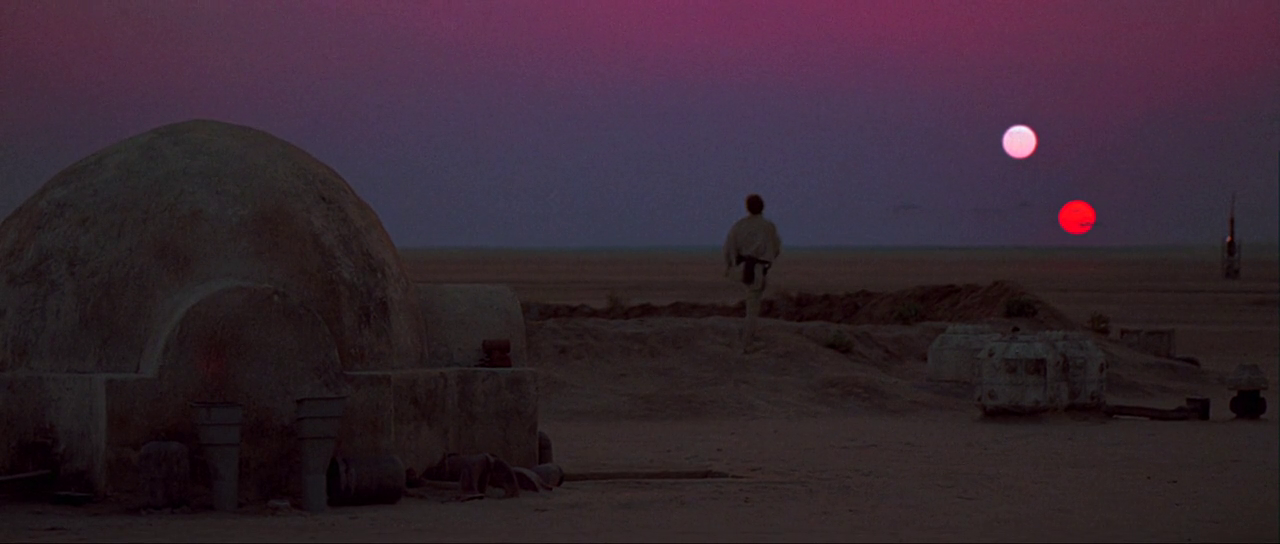
A NEW HOPE
I imagine, for any kid brought up on a steady diet of Republic serials, Flash Gordon, Buck Rogers and the like, A New Hope is and always will be as mindblowing as The Matrix. However, we’re now living in a world where The Matrix happened.
It might seem unfair to compare a 30 year old film with the film that defines the last ten years of action cinema, but the fact is, The Matrix was able to marry fantastic, ambitious ideas to its directors’ influences with staggering success. Lucas himself pulled off that trick with THX 1138. For A New Hope, the film’s cavalcade of ideas certainly elevates it slightly above its pulpy roots, John Williams does Herculean miracles with his score, and many have played in this sandbox since to give those concepts room to breathe, including Lucas, obviously. Despite this, the film alternates between being inventive and breathtaking and being frustratingly tiny. The original film from whence all things Star Wars were born comes off more as a rough and tumble statement of purpose than a particularly great piece of science fantasy in its own right. It’s worthy of respect for what it was rather than what it is.

Leia had already had a hectic, stressful day, only to find out her Droid chose NOW, of all times, to download Ice Cream Sandwich.
What it is, however, is still damn satisfying. Even with its budget limitations, Lucas’ shorthand direction in spots, and its reckless pacing, the film’s energy is infectious, and if you’re in for a penny with the opening shot of the rebel blockade runner being dwarfed by a Star Destroyer, you’re in for a pound. Not a hard decision when dealing with that first grand introduction of lightsabers or with dogfights in space, shootouts with lasers, taverns full of aliens and whatnot, though Jabba The Hutt’s cameo stops the movie dead. When the film gets down to the familiar, expected beats, and keeps hitting them nonstop, there’s this down and dirty passion to Lucas’ direction that’s contagious, a fire under his ass that we don’t really feel in earnest again from Lucas as a director until Revenge of the Sith‘s second half.
The film may be so beholden to the Hero’s Journey that Joseph Campbell’s corpse is blowing a rape whistle, but it’s quite confident in its characters to make that journey resonate with the audience, and that confidence is earned. The mentor, the rogue, the princess, the boon, all the happy horseshit they forcefeed you in College Mythology 101 is here, but with just that special tweak to sneak in past any modern cynicism about the archetypes. Even with her here today, gone two scenes later regal accent, it’s still a goddamned shame how few females in this genre come off as steadfast and determined as Princess Leia, especially considering the sheer amount of justified reasons she would have to have herself a girl moment and weep. For fuck’s sake, the girl’s home planet gets annihilated, and 5 minutes later, she’s just seething in her prison cell, waiting to snark at the first short Stormtrooper to walk in the door. It’s subtly kind of badass, really, and it makes her chemistry with Han Solo work even better. Where Harrison Ford’s Han Solo is a guy on the far edge of control of every situation, a niche he’s pretty much forged a career out of, Leia’s a rock through all of it. He simply can’t charm his way into control of her, as the audience is expecting, and the film is better for it.

They were prepared for Stormtroopers. They were prepared for the tractor beam. Finding the Empire’s onboard Waffle House was a different story. Suddenly, escape was less of a priority.
Ironically, the weak link of the film is Luke Skywalker.
I’ll gladly take the time to exonerate Mark Hamill on this, since the guy acquits himself without even a hint of self-consciousness to every ridiculous moment of this story, every ridiculous aspect of his character. Seriously, kid’s playing with his favorite X-Wing toy when he’s giving 3PO an oil bath. And he’s NINETEEN. No wonder he had a hard on for Leia. Regardless, in the context of the series, Luke’s petulance in New Hope represents a three-part arc that does pay off later, and the ultimate resolution of a 6-part arc mirroring his father’s failures to evolve, but here, his role in the film ends up being not a hell of a lot more than audience cipher. And what little he does get to play with amounts to a child’s wish fulfillment than anything. Luke’s arc in the film is from being a teenager with hopes and dreams to being a teenager with hopes, dreams and a lightsaber. Oh, and, just as an aside, he gets to fly a spaceship and save the day.
This would be fine if things were really so simple in a galaxy far, far away. A New Hope is almost a victim of its own success in that regard. In trying to give Star Wars more weight than the average Republic serial, he opened the door of the audience’s imagination to an all-consuming force granting superpowers to those who believe, a totalitarian government that has somehow snatched control of an entire galaxy, with an uncharacteristic amount of democratic complicity involved it seems, and to an underground rebellion scrapping to be free. The impressive part about all that is how much of it we glean and imagine, not because we know the pre/sequels happen, but because we are told. For a guy whose strengths lie in visuals, so much of the larger galaxy here is built in hints and dialogue. And yet, even violating the cardinal rule of screenwriting, for large stretches of time, it works. The problem is, the film never delivers on those promises in this film. Luke’s victory on the Death Star could’ve still been dumb luck. The importance of Darth Vader’s status as fallen Jedi is given to us in scraps. Aside from a tiny little ceremony, we never feel like the Empire is stopped at the end of A New Hope, and certainly not like the galaxy is breathing any sigh of relief that the ultimate weapon has been annihilated. The galaxy shrinks in this film, after spending most of its first act expanding it.

Adding insult to injury, not only had Princess Leia stolen technical schematics for the Empire’s ultimate weapon, but stole their copy of Minesweeper. This would be a day long remembered, indeed.
All that in mind, the relatively quaint nature of A New Hope is both asset and weakness. Its strengths come from a vast array of of eastern and western ideals thrown together in a crockpot with good old fashioned 40s sci-fi schlock, and while the result remains enjoyable and earnest, it also leaves its best ideas stranded. It’s not an effort that holds up invincibly to the ages, and it would have irreparably suffered if it had been a standalone film. Of course, the sequels actually happening helps. Lucas’ attempts to add to that experience with his new toys makes sense in theory, trying to spit shine a job he left hanging 35 years ago, but he’s putting 2010 rims on a 1973 Gremlin. The result is occasionally exhilarating (The X-Wings at the Battle of Yavin, additional Stormtroopers when Han gets chased in the Death Star, the expansion of Mos Eisley’s scale), but too often just proves jarring, as the world Lucas builds here opens up for these brief instances, and immediately closes. Still, Lucas, ever a businessman, crams enough action and at least lip-service to his ideas to fulfill the greatest role a showman ever could, especially one crafting popcorn entertainment like this: Leave ’em wanting more.
3.5/5
It’s a strange connection, but thinking about Empire, I keep thinking of that bit from Once Upon A Time In Mexico, about Johnny Depp ordering the same roasted pork dish in every restaurant in Mexico. He determines the plate he has in front of him is good, the best he’s ever had. In fact it’s too good. So good he plans to walk into the kitchen and shoot the cook to keep the scales balanced.
Empire is almost incongruous with A New Hope for how much stronger a film it is. All of Lucas’ involvement with the film, and he neglected to tell Irvin Kershner he’s making a 1930’s serial. This is the bar by which the rest would be judged, and as its own left turn into deeper depths than sci-fi pulp really warrants it’s a wonder of storytelling. A greater, more impactful series emerges here, only to get stomped back into compliance only one film later.

Say it with me, people: EEEEEEEWWWWWWWW.
Lucas had a universe to build in A New Hope, attempting to grant scope to a threadbare story, and he never had time to explore any of his best ideas, never knowing if he would make another one of these ever again. With the setup done, Empire feels at ease from minute one, and advances everything we’ve been told within minutes, as we’re introduced to the state of the rebellion, the off-screen development of Han and Leia’s relationship, and Luke minor prestige status. And from then on, there’s not an ounce of fat on the thing. No one seems to be second guessing their characterizations as it seemed in the first. The exposition we get keeps the film and the series, on a constant march forward. The film still short-shrifts the rebellion after the initial spectacular assault on Hoth, but we trade that awareness of the wider galaxy for a laser-point focus on two stories: Luke beginning his Jedi training in earnest, and Han, Leia, Chewie, and 3PO being dogged by the Empire across the expanse of space.
Well, that’s still a bit specific. Empire‘s focus is really on schooling our heroes and the audience on just how outnumbered, outgunned, and outclassed they are in every single way. To this day, the turn the series takes into such oppressive menace and successive fuck-ups on the part of its heroes is still a rare, amazing thing. And the film does so without really becoming dark. It’s just the epic foibles of heroes under pressure, with no sweeping changes to the tone set forth in A New Hope.
The smaller changes that do come, however, are more than welcome. For starters, as mentioned, Luke begins his Jedi training on more than just a pissed off disco ball in this film. And in the category of things that just don’t happen in this kind of movie, at no point do we see Luke succeed. Hamill gets far more to do here, having to not only play a majority of his scenes against a Muppet, but to temper his childishness from the previous film with a (mostly unearned) dorky swagger that dissipates entirely the second he’s tested. It’s a highwire act, keeping this character likeable when he so thoroughly rejects everything glorious, obvious, and beautiful about The Force, and yet he manages it. We still want him to win by the end. How he reacts when he repeatedly doesn’t is great.

It’s a little known fact that in the lulls between the Death Star’s construction, and raids on rebel bases, Vader and Palpatine used to get together and sing Moon River to each other over the Star Destroyer’s PA.
That rejection, and how unkindly the film views Luke is compounded by the time spent with said Muppet, and of all the things Empire builds on, it’s here that the film does its greatest work. Yoda could’ve been ripped from any random Kurosawa film as the kind of guy Toshiro Mifune would play in his later years if 1980 effects work could shrink him about 3 feet. But instead, we rely on Jim Henson and Frank Oz to create what’s still an absolute marvel of a performance that carries the brunt of the Eastern ideas, and makes them absolutely soar. Though I’ve got my reasons for not holding any animus toward the midichlorian thing in Phantom Menace, no one who’s even dipped a toe into the spiritual at some point could deny being moved by Yoda’s explanation of The Force. There is beauty and wonder and power beyond imagination waiting for Luke, and the fact that all of Luke’s mistakes seem to tie back to his inability to grasp what it is Yoda, and really the adult world itself, asks of him provides a true sense of human tragedy to where this film eventually leads him. The dividing line between good and evil fades a bit here, and that lesson hits with monster force by the end of his fight with Vader.
Han Solo’s side of the film feels remarkably weightless by comparison, as it really amounts to little more than a big budget chase. While the setpieces by themselves are a joy, they, by themselves, do not an arc make. They’re pure adventure and spectacle, and little else. That said, although he does remarkable work with the action, Irvin Kershner’s smaller film background, and Lawrence Kasdan, fresh off his work on Raiders, go to work here. The simple dialogue, physical drama, and comedy here are executed with a sure hand. The film seems to keep a tight rein on how adult Leia and Han’s relationship becomes–stuff like “scruffy looking nerf herder” tries just too hard to keep the film grounded in cheese–and 3PO reaches Jar Jar levels of annoyance here, but for the majority, it feels natural and right, and most importantly, engaging. The character work given to Ford and Fisher and, to a lesser extent, Billy Dee Williams when the Empire’s doing its worst makes it feel like we’re watching events with greater bearing on plot than there really are.

When you stare into Calista Flockhart, Calista Flockhart stares back.
Oh yeah. The Empire. I feel like I skimped on talking about this with A New Hope, because, really, in that film, the Empire is more of a generic evil with one hell of a secret weapon than an all-encompassing threat, but its unavoidable here. The rebellion disappears after act one, but from the first appearance of the Imperial March and Super Star Destroyers, the Empire is omnipresent. This is truly an Empire at war here, and even with Vader choking out subordinates left and right, the imperials here are quite the well oiled machine.
Which, of course, brings us to Vader himself. You know what no one talks about with A New Hope? How much of a second banana Vader is in that film. Sure, he gets to do the coolest stuff, but that line about Tarkin holding Vader’s leash isn’t just Leia being cute. Vader is a hired gun in that film, just the one with the best costume, and he’s still taking orders from Governor Van Helsing. So, it’s a bit strange seeing him in charge during this film, especially since he failed pretty spectacularly in the last one. Lucas obviously knew he stumbled on to something worthwhile here, though, and lets the audience just run with it. He still takes his orders from the Emperor, though the infamous revelation later makes his conversation with Palpatine an deft little question of motivations instead of just a moment of commands coming down from the top. However, this film, there’s no question Vader is the villain, and it allows him to be his badass self, often. Vader’s off that aforementioned leash here, and it’s an amazingly ruthless thing to behold.

The price for defying the Empire is paid not in blood, or limbs. It’s in being appointed Michelle Bachman’s gynecologist.
By the end of the film, after Vader’s big reveal, we’re left with a very different Star Wars. Our last shot has Luke and Leia in their last minutes where they’re allowed to be scared children. Han Solo’s frozen and carried off by a bounty hunter, and the only victory anyone can claim is that everyone’s still alive. And yet, somehow, Lucas and Irvin Kirshner manage to send the viewer off on a high, exhilarated note, based on the complete and uncompromising failure of its protagonists to accomplish anything. That’s a master stroke of pop artistry there, the kind that earns the power lent by John Williams’ score and Lucas’ extraordinarily large budget. The kind where I’ve spent hundreds of words thinking of a weakspot that isn’t a nitpick, and coming up short. The film remains as close to perfect as science fantasy can get.
4.5/5
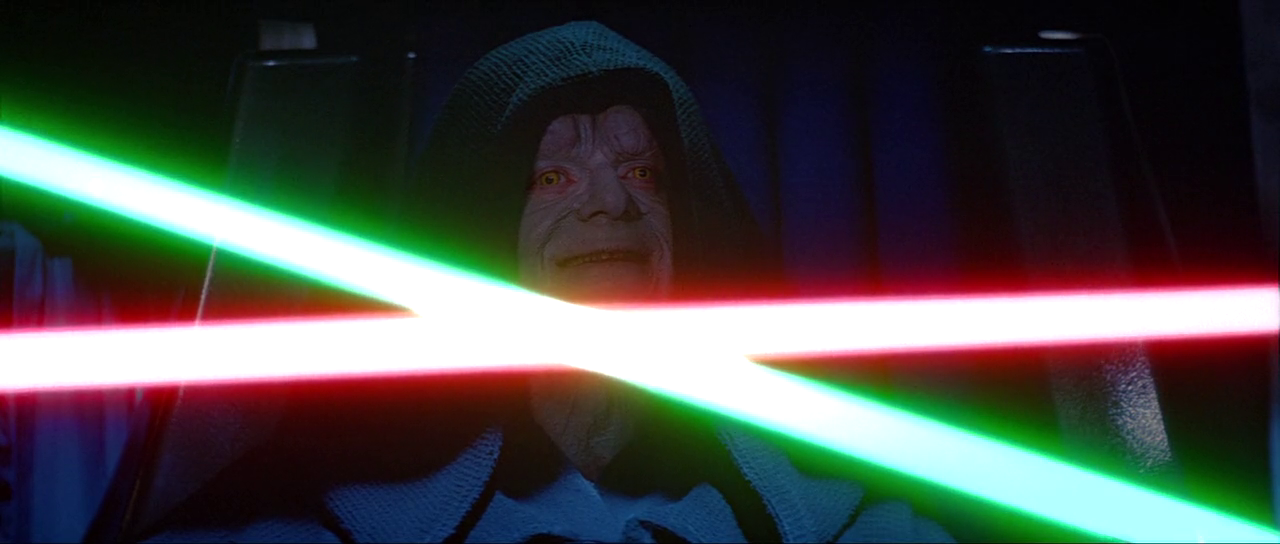
RETURN OF THE JEDI
I suppose there’s some merit for the attempt to keep Star Wars a piece of trashy, dimestore comic sci-fi, even after such a satisfying plunge into brilliance, as long as it ties up all the loose ends, and the war for freedom in the galaxy reaches an epic and creative enough crescendo. I really just wish to hell Jedi accomplished any of these things.
It’s not a complete fiasco. Stitch together a cut of the film that’s just Luke Skywalker, the assault on the new Death Star and the last 5 minutes or so, you at least have something that supplies a few visceral thrills, and brings the story of Luke Skywalker: The Last Jedi to a satisfying close. But you’d be left with a film approximately a half hour long.

It’s as if millions of 80s boys cried out in puberty, and were suddenly sexless.
It takes 40 minutes–nearly half a feature length film–for Return of the Jedi to get away from Jabba The Hutt’s palace and actually get down to the pressing business of fighting the Empire and Luke attempting to continue his training. 40 minutes for a sequence that has no right being longer than 15, tops, and that kneecaps the development of key characters. Leia comes out as eye candy and as a lovesick teenager trying to rescue her boyfriend, and no, murdering Jabba does not make up for it. Han Solo is rendered useless during a situation that’s entirely his fault and is never acknowledged again. The faceless, glowering bounty hunter we are teased with for two films now is completely wasted and gone within seconds. All the while, any scraps of lingering positivity one could’ve held for C3PO are completely dust after seeing him flail around incompetently for this stretch, and it doesn’t get any better later.
Post-Jabba’s palace, a decent Star Wars film finally begins, Yoda has a beautifully melancholy final scene, Obi-Wan’s ghost gives us some dubious exposition, a plan is formulated to destroy the second Death Star (which really screams of “Yeah, we couldn’t think of anything more badass than a space station that destroys planets, so we’re gonna roll with the old”), and things finally get a move on, right up until we land on the forest planet Endor, and Leia crashes where the teddy bears have their picnic.

That dug really ties the room together.*
From here, Star Wars grinds to a halt for a 20 minute 80s cartoon intermission. These creatures represent no real threat, or tension, or entertainment value besides being cute and cuddly, which is just creative death. Even once it’s determined our heroes are not, in fact, going to be eaten by the mutant koalas, we’re saddled with them for the rest of the film. The on-the-ground climax even hinges on them. It’s not like there’s no room for twee in this series, but not at the expense of the three-pronged defining battle of the series, and certainly not when it means absolutely neutering one of the series’ greatest assets, Han Solo, for the remainder of the film. He ends up incompetent, petty, and far too often as comic relief. In this film, Han Solo is Willie Scott. And it’s a goddamn waste.
As mentioned, though, at least the other two main battles are quality. While using the Death Star for a second time is lazy, and I still question the nuclear-bomb-on-an-anthill logic of why the hell a station designed to destroy a planet being used to snipe smaller ships out of the sky, Marquand at least delivers visually, with some God’s honest tension to boot as it becomes more and more likely that the rebellion is trapped in an unwinnable battle.
Ironically, for a film that doesn’t seem to have a grasp on how to end its story in any meaningful way appropriate to what’s at stake, it does a bang up job tying the failure of the rebellion back to Luke’s struggles with the Dark Side. Sadly, the best and most interesting character development of the film happens offscreen, as the first time we see Luke Skywalker, he’s decked in black, not a hint of teenage whine in his voice, using new Jedi skills, and issuing cold threats to Jabba. The details of his continued training are never addressed, but the steely confidence of his character is a far more welcome presence in this film than any prior, and Mark Hamill embodies it without breaking a sweat. He’d obviously been waiting two films for this character to get to this point.

“Wait, Ben…you’re a ghost. How are you sitting right now?” “You just watched a Muppet vanish into thin goddamn air, and THIS is where you ask questions? FUCK YOU, that’s how I’m sitting.”
Apparently, he steals some of that determination from Vader, who is too often relegated to Sith bitch seat, spending the vast majority of his screentime once the Emperor arrives on the Death Star stating how powerless he is against the Dark Side. He’s not completely diminished, as his scenes taunting Luke and being confronted with his own past as Anakin Skywalker prove handily. But when he finally tosses Palpatine down a vent shaft, it’s an unmistakable act of compassion. While his sudden rush of anguish makes sense for where is in this film, i.e. watching his son get tortured nearly to death, it’s still a rather swift change from how we view him in Empire, and certainly not nearly enough proof of the good Luke sees in him that stays his hand after he lops off Vader’s. The film is more convinced of Anakin Skywalker as a fundamentally good man than the audience is.
Maybe’s it’s supposed to be good by comparison to Ian McDarmid’s Emperor Palpatine, and if Jedi gets nothing else right, it’s this. Palpatine is every single inch the satanic figure we’d expect given what the audience knows about the Dark Side of the Force so far. McDarmid’s eerie, reptilian performance, sucking the meat off every syllable that leaves his lips, manages to unnerve and seduce in equal measure. We don’t want him to succeed, but we’re still compelled to want to hear him talk, entice, and entrap. McDarmid’s presence just plain screams ancient and ominous. The evil he brings, the way he drip feeds the guilt of all that has happened onto Luke is beautifully wicked, and every second he’s onscreen, even after Luke and Vader cross lightsabers, Star Wars is worth every Shakespearean/mythological comparison ever made about it.

The Vader: (n) What to do when it’s Friday night, you’re a nerd, and you’ve got an artificial right hand.
It’s the creamy center to a really disheartening whole, though. The very ending, taken on its own terms, feels like a greater film unfolded, especially when we finally see planets across the galaxy united in celebration about the fall of the Empire, and Luke is able to witness the good young man who was his father in the ethereal flesh for the first time. I suppose, for the moviegoer who’s that greatly affected by the final notes of a movie, Jedi sends Star Wars off on a rather effective high. But realizing just how little of what is being resolved in these minutes corresponds to what actually transpired for much of its runtime sends the entire structure crashing down. The only thing Jedi has in common with New Hope is that what we remember from it is a lot less than what Jedi, as a whole, actually is. And what it is is a fucking mess.
2/5
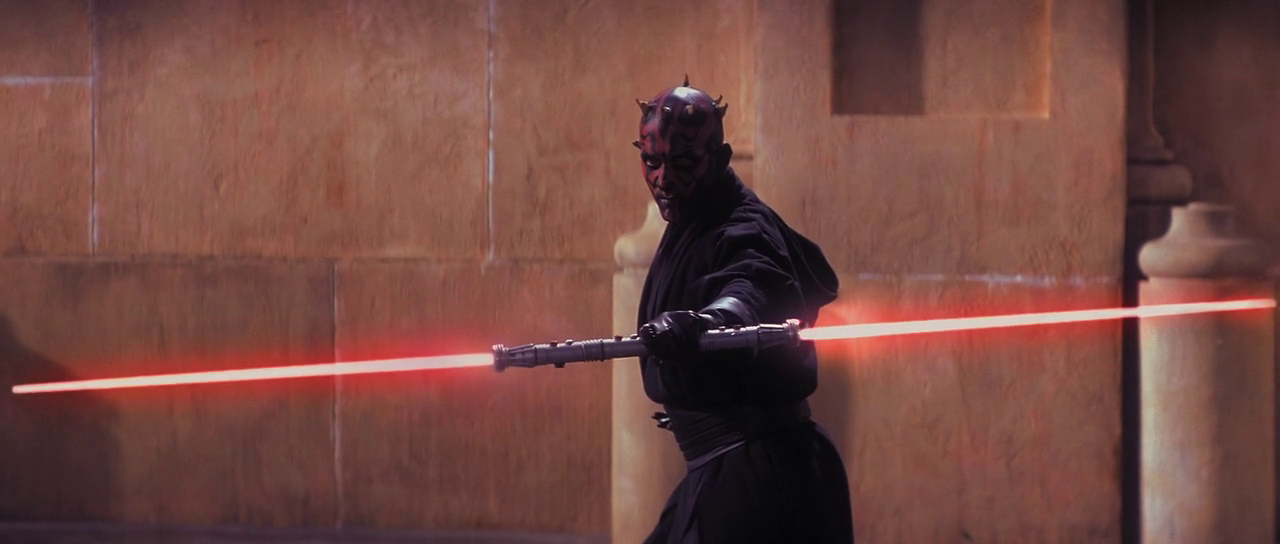
THE PHANTOM MENACE
A couple of years ago, one of Stephen Colbert’s infamous Green Screen Challenges had viewers splicing in footage of Stephen swinging a lightsaber and screaming about slicing up space monsters into various situations, and out of nowhere, Lucas himself showed up with a special ILM-produced entry. It was amusing, self-aware, and had some stilted, goofy satire, but it wasn’t exactly Grade A work, from ILM, or Lucas.
You know what review you’re starting here, so, this is the one and only instance where you can guffaw and say “Just like the prequels” without coming off like a twat, so, enjoy it, you’re welcome.
This is essentially what The Phantom Menace feels like, however: An attempt by Lucas to play around in his own universe the way so many others have prior. It begins the most epic series of fan-fiction ever created.

“So, Mr. Li, was there any one incident that led to the banning of NC-17 content on Fanfiction.net?” “Well, it wasn’t one thing, but if I had to narrow it down….”
Like I said in the preamble, pop culture doesn’t exist in a bubble, and 19 years removed from the initial experience that made Star wars religious, there was never any way for the prequels to remain untouched by expectation. They are fully aware of what Lucas believes is expected, what they need to be to matter. They are calculated.
So, not surprisingly, The Phantom Menace is a kid’s film.
At the very least it’s trying to be. A new Star Wars film is a cultural touchstone, Lucas knows this, and tries to make the playing field as level as possible, trying to open the door as wide as possible for that late 90s 6-year-old kid, raised on a steady diet of Cartoon Network, to come in and find something worth latching on to before going in for the kill on what we already know will end in tragedy. We go from stormtroopers to cartoony robots, grimy used future aesthetic to sleek, polished curves, a new breathless freneticism to the action, and juvenile new main characters sharing center stage right alongside the adults. This is, however, at war with the political clusterfuck at its dramatic core, a truly terrifying Sith apprentice for a villain, the subtle and repeated warnings that our child hero is something to be feared, and a repeated mining of the original trilogy, a trilogy which often flies in the face of all these sensibilities, to give specific scenes resonance. The Phantom Menace is a film trying to have its cake and eat it too, a kid’s film that talks up to and down to its audience all at once, and only rarely sees it eye to eye. The result is, like Jedi, a mess. But a mess of a different sort.
Perhaps the most important distinction is that it’s an honest mess. This is very much the film George Lucas wanted to make, involving the things that excited him about Star Wars circa 1999. Where Jedi has a throw-shit-at-the-wall kind of feel to it, George Lucas is a man truly discovering his love here, picking up his old toys as an adult, finding things that turn him on creatively, and trying to make that joy just as contagious to a younger crowd as A New Hope was. Unfortunately, the experience of The Phantom Menace no longer feels universal, but specific to Lucas alone, and there’s a sheltered naivete to that joy that not everyone will accept, if anyone in this day and age. When your first act involves a floppy, clumsy sea dwelling native with a Stepin Fetchit accent, that aversion is justified and righteous.

“Look, I know you really, REALLY want a shot at an Oscar, Natalie, so take it from me. Getting your face painted up white, wearing an outfit with feathers sticking out anywhere? Not the way to go about it. Trust me. When I’m done here, I’m gonna go do this movie with Johnny Depp. They haven’t told me what it’s about, but I’m sure it’s pure class.”
However, even if it wasn’t saddled with the mistake that is Jar Jar Binks, this is a different universe, and not one without its merits. For one thing, the Star Wars universe has always been a cold place of steel and machinery, a fact the script even points out at one point. There’s still that, but there’s a richness to the environments of this film that puts the viewer in a different mindset almost from jump. Tattooine actually feels like a nomadic metropolis than a tiny wretched hive of scum and villainy. The cityscape of Coruscant is Fritz Lang’s art deco wet dream. The invasion of droid armies on Naboo genuinely feels like the incursion of something foreign and wrong on a truly beautiful place, something the OT never emphasized. The strength of that primal sensation is meant to translate the complexity of a trade route being forcibly disrupted to someone who doesn’t get it, and it hits its mark, especially when the fight between Gungans and the droids comes one badass war chant short of evoking the best goosebump-inducing parts of Zulu. The biggest problem is the dialogue should be doing at least some of the heavy lifting there, and there’s just no way to make a commerce dispute not come off as C-SPAN Lite, and that’s without the elevated tone most of the film takes with much of its spoken dialogue.
This too, winds up being a case of Lucas trying to do two things at once. On one hand, he wants the whole space opera thing to be taken seriously, but from a film where there’s so much childishness on hand, it just comes out as stiff and unwieldy from many of its players when performed, though Liam Neeson, Ewan McGregor, Ian McDarmid, and a smattering of others manage to make it sail. Meanwhile, poor Jake Lloyd is forced to approximate Lucas’ reading of a 9 year old, and anyone who’s been around a group of 9-year-olds should realize how he gets it 100% right. Unfortunately that means, occasionally, he’s a socially daft little shitstack. Funny enough, given his over-reliance on CG, the two best performances in the film are computer generated: parts dealer Watto brings a brilliant earthy scumbagginess to the proceedings, and the younger iteration of Yoda is perfect, injecting an acutely shrewd Shaolin monk zen to the performance that his older counterpart could hint at but not attain, by nature of the character’s age and the fact that it’s a puppet.

“Liam, did you swap the video feed on that thing for Schindler’s List like I asked?” “Yup. Worked like a charm, didn’t it?” “And they said I wasn’t good with actors. HA! Lose the robes, man, we’re goin’ to Black Angus.”
Even with all this, new Star Wars is its own ambitious, strange amalgam of storytelling and subtexts, and it goes stretches where it succeeds, once you get past the jarring, clumsy first act. The pod race is a marvel. Qui-Gon’s dealings with Watto and Anakin’s mother are the closest the film comes to feeling like actual, warm-hearted, personal conversations are taking place. The politics of Palpatine making his move on the Senate are well-handled. Palpatine whispering suggestions to the child queen and leading her to exactly the outcome he wants is one of those fleeting moments the film aims high and hits its target, as does the grave foreshadowing that slinks around the third act. The film takes a pretty great, simplistic stance on war as a drastic measure, not an immediate given when rights are threatened, and the fact that there are kids who pick up on that gladdens the heart. And of course, there’s everything about Darth Maul. Everything.
The Jedi being in full power, and how they collectively react to Anakin being a vergence in the Force is right in the middle. On one hand, it’s confusing how anyone in the original trilogy could see these guys as myth or hokey religion when it wasn’t more than 30 years ago when these guys had a fancy-ass temple sitting out in the open on Coruscant. On top of that, baby Vader turning out to be a virgin birth is far more on-the-nose than it should be, though Pernilla August deserves quite a bit more love for bringing a ton of unspoken human softness and regret to what could have easily been a thankless role. On the other, it’s fascinating that Lucas has us questioning the spirituality that we’ve spent three movies taking as gospel. I don’t know what kind of spiritual journey Lucas himself has taken in 20 years, but his issues come out onscreen, and it adds a tinge of complexity to what has been and should never have been such a black and white–or, rather, dark side/light side–issue. Having Qui Gon explain The Force in both scientific and religious terms to the Immaculate Force Conception is subtextually fascinating, and speaks depths about the kind of Jedi Qui Gon is as opposed to his contemporaries, but, admittedly, it robs a certain human poetry from what was once spiritual simplicity. This is the underlying problem with The Phantom Menace that permeates the entire new trilogy. While the original trilogy is guided by the adventure-loving heart, much of the prequels are guided by the rational, technological brain, and rarely do the twain really meet.

The Hollow Man is dangerous. They all sense it. Why can’t you?
The Phantom Menace, on its own terms, is a film that easily ends up just bewildering kids, and disappointing adults. An atrocity, however, the film is not. In its own way, it simply suffers from the same problems as A New Hope, in that Lucas presents grand ideas, but his focus is films away, on what could be done with the foundation he lays down, not on the collateral story damage here. Still, Lucas wants everybody, not just everyone who was a fan 20 years ago, along for the ride, and he tries to make The Phantom Menace float on its own as a self-contained journey, and it doesn’t work. But, again, it’s an honest failure. Lucas isn’t raping anyone’s childhood. He’s trying to please his own.
3/5
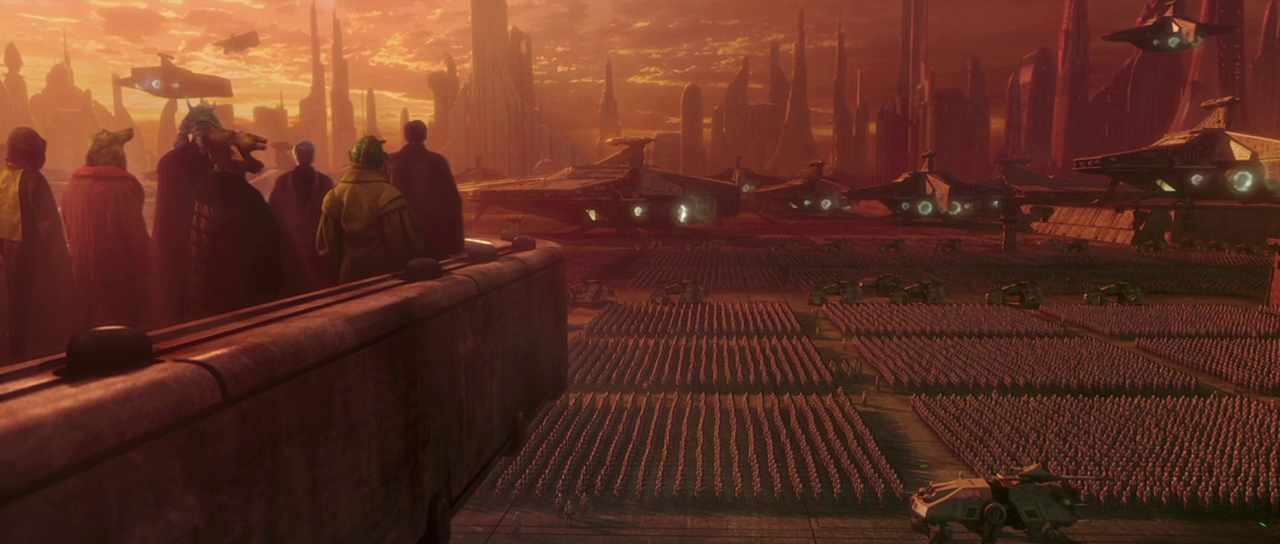
ATTACK OF THE CLONES
Well, I did say in my Jedi review I was okay with Star Wars being trashy, dimestore, and pulpy, as long as the plot moved forward, didn’t I? And yes, Attack of the Clones does some passable work advancing the political intrigue that Phantom Menace skirted with, and upping the old-school spectacle factor, almost to its detriment. Unfortunately, Attack of the Clones is also home to a trashy, dimestore, pulpy romance. And taken at face value, and why the hell wouldn’t you, good crossdressing Christ, that romance is assholes.
Here’s a secret, though, and the reason, despite watching Padme and teenage Anakin uncontrollably ooze schmaltz on each other, that I still can’t bring myself to entirely pan Clones based on the pain of Anakin and Padme’s romance: George Lucas doesn’t like teenagers.

Don’t worry, scrote. There are plenty of ‘tards out there, leading kick-ass lives. First wife was ‘tarded. She’s a Jedi now.
If there’s a teenager in a George Lucas film, chances are, that teenager is a dick. That teenager is irresponsible, brash, loud, and ill-equipped to deal with anything or anyone on any mature level. And while there’s always a certain level of attraction to that, Lucas is rarely, if ever, on their side. Eventually, they grow up and become something great, like Curt in American Graffiti, who gives up on his mystery blonde, and becomes a writer, and even Luke Skywalker, who later makes hard choices for the good of himself, his family, and friends.
Others, like Anakin Skywalker and Padme Amidala, get married and get each other killed.
Does that make for good film? At least, as far as Episode II is concerned? Not really. But in telling the story of two teenagers who have no idea what the fuck they’re doing, Episode II at least builds up some basis in the scene on the ship to Naboo as to why these two are pants-on-head retarded for each other; that basis being, he’s a horny teenager who hasn’t had any meaningful contact with a non-alien female since he was 9, and she’s a stunted almost-adult whose emotional interactions with people have only been with her handmaidens. These two latch onto the first boy/girl who shows any interest, and it speaks volumes that Padme goes into almost a trance when talking about her first kiss, a handsome kid who ends up an artist. Their official roles are all they know. So, of course, he goes intolerably overboard with the smooth talk about getting sand in his crack, and she falls desperately in love with the handsome boy who rages because he’s not a good enough Jedi. And on paper, this is FINE. Lest we forget, Romeo and Juliet aren’t exactly known for their restraint when they meet each other, and that’s in the versions where Romeo’s NOT tripping on X. But for much of the first act, we get nothing except these two spewing every expectorant line with a Merchant Ivory seriousness that just hurts the audience, and wishes to go on hurting the audience.

A surburban white kid going out on a motorcycle to see a sketchy stolen goods dealer about finding his mom half dead in a crack den. This movie has applicability out the ass.
The non-romantic parts of the film fare a bit better, though it’s got a raging, malignant case of middle chapter syndrome. The actual plot, with Obi-Wan investigating an assassination attempt on Padme, and stumbling across an army of clones created by a Jedi who was killed 10 years ago comes off as cool while it’s happening, but, God, just typing that rundown of what’s happening was arduous. Trying to explain it to someone seems like something you’d need to call a board meeting for. The bush-league execution of said plot is a nebulous, wheel-spinning affair until its third act.
Unfortunately, Lucas makes the same big budget film mistake as his contemporaries here: letting better and louder action and visuals entirely patch over his shortcomings. And yes, credit where credit’s due, the film is overflowing with action, and aside from a too over-the-top sequence in a droid foundry, that action is uniformly fun. Not only do we get some measure of redemption for Boba Fett going out like a punk two movies ago, but seeing a couple dozen Jedi, all together, right before our first taste of Stormtroopers–gasp!–actually doing their job does have its charm. But a weariness sets in by the end. It’s too much rhyme for not enough reason. It’s the old candy analogy of too much of a good thing , and it very nearly kills the film outright. Anakin wielding two lightsabers when facing Count Dooku should be badass. Instead, even the short time it happens is almost overkill. Yoda shortly after gets his own lightsaber duel, and it’s right on the border between utterly thrilling, and utterly fucking ridiculous.
The real saving grace of the film is the undercurrent of foreboding that carries over from Episode I grows just that perfect bit louder here. The sound and fury may signify nothing, but little moments of Machiavellian plotting manage to peek through. Padme shooting Mace Windu a “bullshit” look after stating that Count Dooku isn’t capable of murder. Every hint given by Yoda that the Jedi have grown arrogant, and are losing their connection to the Force as a result. The entirety of the material on Tattooine is well done. Christopher Lee just classing up the joint as usual, and telling Obi-Wan right to his face that Darth Sidious is trying to take over the Senate is the best brand of treachery. The greatest part is the one piece of dialogue that sticks with the viewer after it’s all done: “Begun the Clone War has.” Yoda grimly stating that a war starting is no reason to celebrate, right before we see Stormtroopers, Star Destroyers, and Palpatine overseeing their implementation. It’s truly gooseflesh inducing stuff, especially when juxtaposed two seconds later by Palpatine’s greatest creation getting secretly married some lightyears away. But then, endings have never been Lucas’ problem.

Size matters not. Noticing Count Dooku’s fly is open at the worst possible moment does.
The thing is, if Lucas intended for the prequels to advance with his new audience, why is this stuff not the text of the film at this point? He gives kids who jumped on the train with Phantom Menace and his own fans too little credit. Clones feels like a series of concessions and apologies for the perceived flaws of The Phantom Menace instead of a genuinely charted course towards a full-on action packed adventure, leaving a(n utterly spectacular Genndy Tartakovsky) cartoon to pick up its slack. Lucas has fun with it, but the film as a whole comes off as irresponsible, brash, loud, and ill equipped to deal with anything or anyone on any mature le–
Oh.
2.5/5
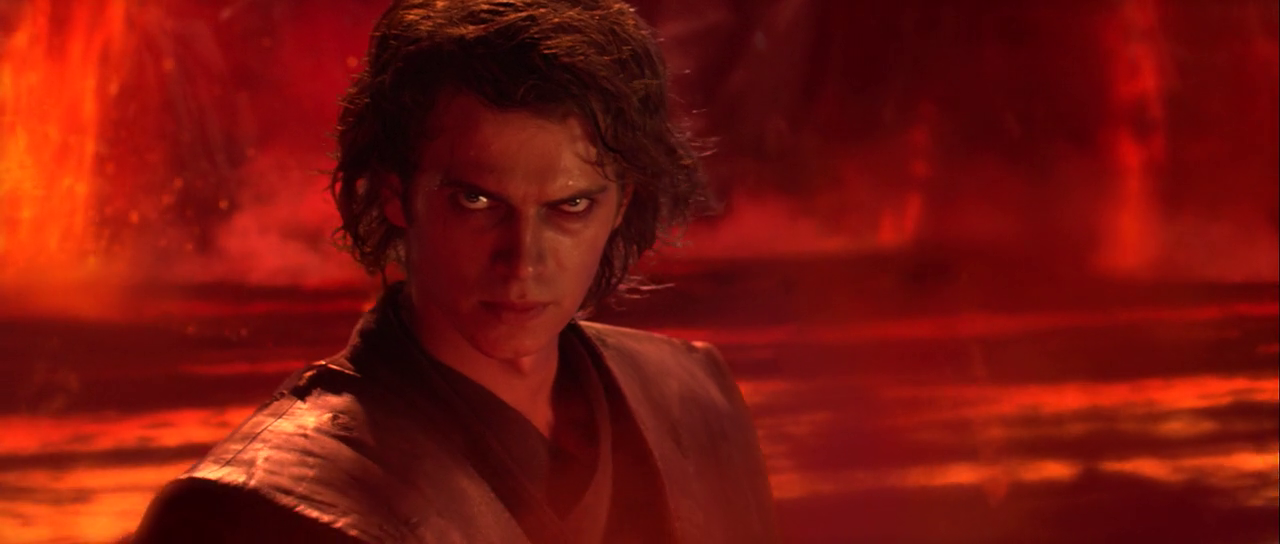
REVENGE OF THE SITH
The Empire Strikes Back feels like nobody told Irvin Kirshner back in 1978 he was making a 30s serial. The prequels’ biggest problem is that EVERYBODY told George Lucas he was making grand modern myth, EVERYBODY took the term “space opera” literally, and somehow people were surprised that he started believing them. The Phantom Menace and Attack of the Clones represent attempts to treat Star Wars with the same arch reverence as everyone else, and this is utterly in conflict with how Lucas obviously really feels about his creation, which is far less complicated. Still, the man tries his damndest time and time again to turn Kool-Aid into Cabernet, and for the last two films, it’s been just plain out of his reach.
Revenge of the Sith is different, though. Revenge of the Sith requires that marriage of ideas and ideology. Sith requires the boom to be lowered. Sith is arguably why Lucas made a prequel trilogy. It is the sum total of all that is what Star Wars was, is, and wants to be. All its successes, all its failures, all its quirks, its beauty and sloppiness, all its pretensions, its respect for its influences, and its unchecked ambition. It feels the Star Wars film George Lucas has truly wanted to make since 1977. It goes completely for broke in every way.
Somehwere around the time Anakin and Padme silently stare across the expanse of Coruscant at each other, for each other, for the first time since 1980, all that is Star Wars sings in unison. And more often than expected, quite beautifully.

It is not the ignominy of death that troubles Dooku. It is the knowledge that someone, somewhere, at that moment, is watching him in Police Academy 7.
There are things to expect from Star Wars at this point. Lucas is still a master visual storyteller and is still able to tap into the primal little kid brain and hit all the right buttons that turn it on. He is still able to create worthwhile characters worth framing a story, or at least moments around. He also excels at scattered atrocious line readings, strange moments of humor, and some basic failings of Screenwriting 101, things that do keep the film from attaining genuine perfection. This, too, is undeniably Star Wars. Lucas still indulges himself too often with his own stilted sense of cool, and yet somehow, he has a higher rate of effectiveness than he has in the prequels so far.
For starters, it helps that he answers one of my personal prayers, and keeps C3PO where he fucking belongs: As a background handmaiden to Padme, out of the action. Meanwhile, he gives the other random droids just enough personality to be quirky without being annoying. Aside from water planet Kamino in Clones, desert planet Utapau, where General Grievous holes up, is one of the more imaginative environments in the series, and the giant grin from seeing Obi-Wan ride into battle on a giant lizard is one of the more satisfying the series has to offer. He also decides to give us a peek at Chewbacca’s home planet for a split second, and though it’s a bit of fanboyish masturbation on his part, in the spirit of giving the closing battles of the Clone Wars their greater context, it’s an indulgence worth including.

Fear. Anger. Hate. Suffering. PSP. It only does EVERYTHING.
What is new to Star Wars is Revenge of the Sith‘s sense of gravitas. What has always hindered the original trilogy is that you only get a sense that the galaxy is in danger because we’re told. Past possessing the ability to destroy planets with the push of a button, the full spread of the Empire’s evil is only felt for fleeting moments. Jedi spends most of its time on two planets COMPLETELY unaffected by the war or the rebellion. The Phantom Menace does better with that, though the stakes feel petty. Clones feels like the lead-in for something bigger, but doesn’t capitalize on it by itself, leaving Genddy Tartakovsky to do far too much of the heavy lifting. We start Sith with the Clone Wars in medias res, with the biggest, most extravagant space battle in the series, the beginning of the end for a conflict that’s been keeping Senator-For-Life Palpatine ass-deep in power for three years, a war that gets twisted into something politically and dramatically dirty later as Palpatine manages to pin his own motivations on the Jedi.
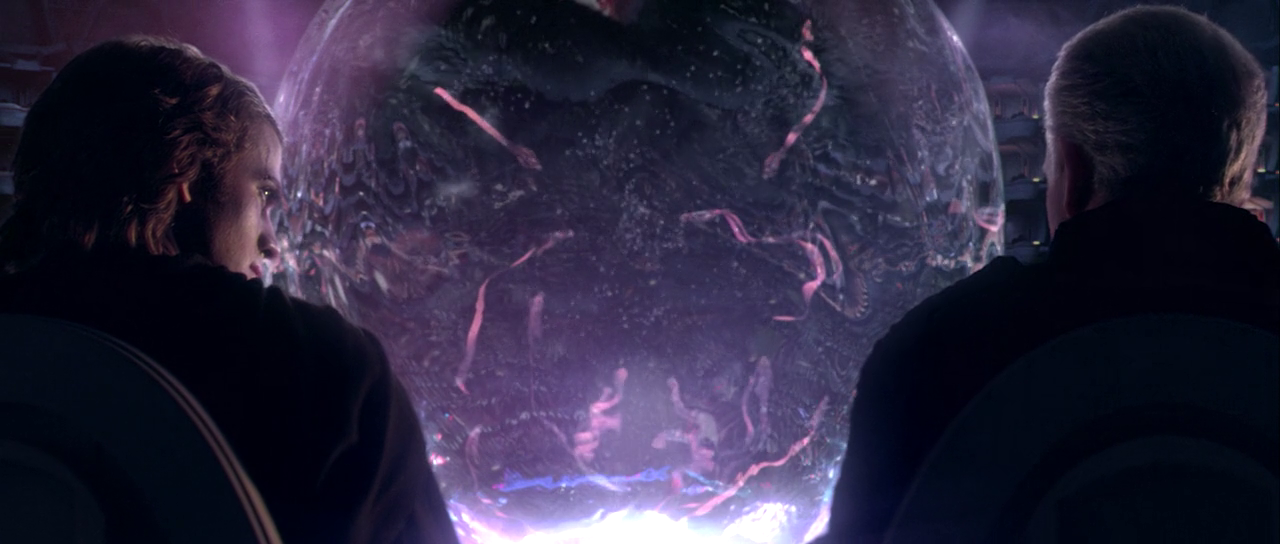
When Palpatine told Anakin they would learn the secret of how to create life together, seeing Enter The Void in IMAX 3D was miles away from what he had in mind.
While The Clone Wars themselves are a masterful double-play on behalf of Palpatine/Sidious, it does at least feel like the entire galaxy is feeling its effects. Motivations are being questioned, victories are celebrated, councils between the Jedi happen from planets away. Later, when Palpatine makes his move, and declares himself Emperor, the readiness of every system in attendance to unite and run with it based on a lie for the sake of their own security is terrifying in its implications, summed up in the senate by Padme in probably the best line to come out of the prequels.
This happens shortly after Palpatine finally pulls his big Manchurian Candidate trump card on the clone army, and has the Jedi systematically slaughtered across the galaxy by their own troops. It’s a montage that plays in the moment as a world-shaking an event on par with the baptism in The Godfather, though a lot of that is John Williams unquestionable masterpiece of a score here. In the whole prequel trilogy, really, but I digress. The power of this sequence is not in the systematic extermination of the Jedi so much as it is in the philosophical failure of all that the Jedi stand for. Mace Windu’s the fall guy here: He is the first to decide the galaxy would be better under Jedi rule, and nearly kills Sidious based solely on that than any defensive need. But this is but the last straw in a series of situations where the Jedi institution never provides adequate answers to a boy, a teenager, and now a conflicted adult who needs them. Training oneself to let go of all they fear to lose might be the path to enlightenment, but “it’s the path to the dark side” is simply not enough of a reason. The Jedi don’t just fail Anakin Skywalker, they don’t just fail to read their own prophecy correctly, they fail their way of life. They fail the Force. And the fact that no one but Yoda sees Order 66 coming from a mile away is shameful.

Once more, NAMBLA will rule the galaxy.
The purge of the Jedi from the galaxy is just one in a series of collective character failures that come to a head in this film. It’s in this that the film does its greatest work and where, at long last, the series is unabashedly justified for the first time calling itself operatic. The idea of a soldier coming back from war, fearing he might lose everything he’s fought for, and selling his soul to Satan himself to prevent it belongs on a stage with a powerful set of pipes to belt it to heaven itself, the kind of treatment none of the films prior ever really beg for or deserve, yet this one earns. Beyond Anakin, however, every single force of good in this film is forced to face their fuck-ups from the last two films head on, from the Order 66 montage onward, and the right choices are rarely made. Anakin himself all too quickly sacrifices his complexity and morality for singular focus on power and freedom without rules, and is horrified when he gets it by having a cyborg suit grafted on. Obi-Wan kept Anakin at a distance, being a mentor instead of a brother in more than name, and never really recovers from that shame. Padme gives up her personal strength for someone she knows is dangerous, and puts herself in the role of not-yet-battered housewife to protect him, until the fateful choke happens. Palpatine fails…..well…not at all really.
As a matter of fact, he’s downright jolly after he calls in Order 66, and it becomes abundantly clear that Ian McDarmid knew where Star Wars was going long before Lucas did. He hits the single wrong note of his tenure as Palpatine when he faces Mace Windu, though that sequence as a whole is big bucket of wrong, but past that, he handles the transitions between an oily, yet gentle stateliness, growling menace, and full-on maniacal cackling evil with aplomb. Not for one second do we question whether the same megalomaniacal overlord who tosses senate seats at Yoda is the same man who places a pitying hand on his charred apprentice’s forehead as he lays in smoldering ruins.

For dry, Sith eyes, Clear Eyes does NOTHING.
All this is the weight that bears down on the final, furious lightsaber duel between Obi-Wan and Anakin, paralleled by a shorter, yet more genuinely epic duel between Yoda, a duel in which the silliness of the fight with Dooku is entirely missing, and where Lucas’ bad habit of crosscutting an action scene doesn’t come off as a sudden and arbitrary. Even with the Anakin/Obi-Wan’s protracted length, even with the sheer technological achievement that is The Duel, there’s an emotional and dramatic heft to these two battles missing from every other fight in the prequels, and it all carries into the final melancholy moments of the saga, with Yoda and Obi-Wan in a constant state of mournful contemplation. While Lucas fumbles a bit of his own success for a goofily executed, but wholly appropriate nod to James Whale, he plays the final notes of Star Wars with a gentle, restrained solemnity.
What’s funny about this whole thing is that popping in A New Hope directly after Sith doesn’t EVER feel like the continuation of the story. It just serves to highlight even more just how small that original film is, given its ideas, and how that guy in 1977 has advanced, and hasn’t. Lucas would get to see Star Wars to fruition. He would make the biggest, wildest sandbox ever to house his vision of an Edgar Rice Burroughs space drama. He won’t get any better with actors. He’ll still struggle with consistent tone, logic, with childishness sharing the same room as attempts at high drama and philosophical trappings. The sweat and strife that went into creating the effects would be eased by CGI, some good, some bad. His work will always vary wildly in quality in execution, frustratingly so. But he will get to realize his imagination, without restriction, more than possibly any other director ever will. Everything that was worth doing in New Hope, he will be able to do on a massive scale. He’ll even stumble onto a drop or two of poignancy by accident somewhere in there. And when his films work, they work wonders.

Behind the scenes at CPAC: This year’s straw poll winners look on to their party’s future.
That knowledge of what Star Wars is, and what A New Hope promised in 1977, is all over Episode III. It’s what makes it grand, even in the face of its lamest moments. It feels like the Star Wars universe is being explored to its fullest. All that George Lucas still found worthwhile about that universe resides here. Unlike the other two prequels, he fully believes it this time.
And that is why it doesn’t fail.
4/5
The Package
The Video
You would think A New Hope would have the overall weakest transfer, and there are moments when it is, but what are you gonna do, that print’s been through more shit than Andy Dufresne. But, oddly enough, The Phantom Menace wins that prize, as it’s been beaten pretty hard with the DNR stick, and far too often. That waxy quality just invades the frame and robs the image of some of its vibrancy, of which there should be LOTS of in TPM. It’s not a total Predator SE disaster, as much of the cityscapes look as majestic as they should, but the transfer seems like it’s trying to make a celluloid film look like it was shot in HD, and failing at it.
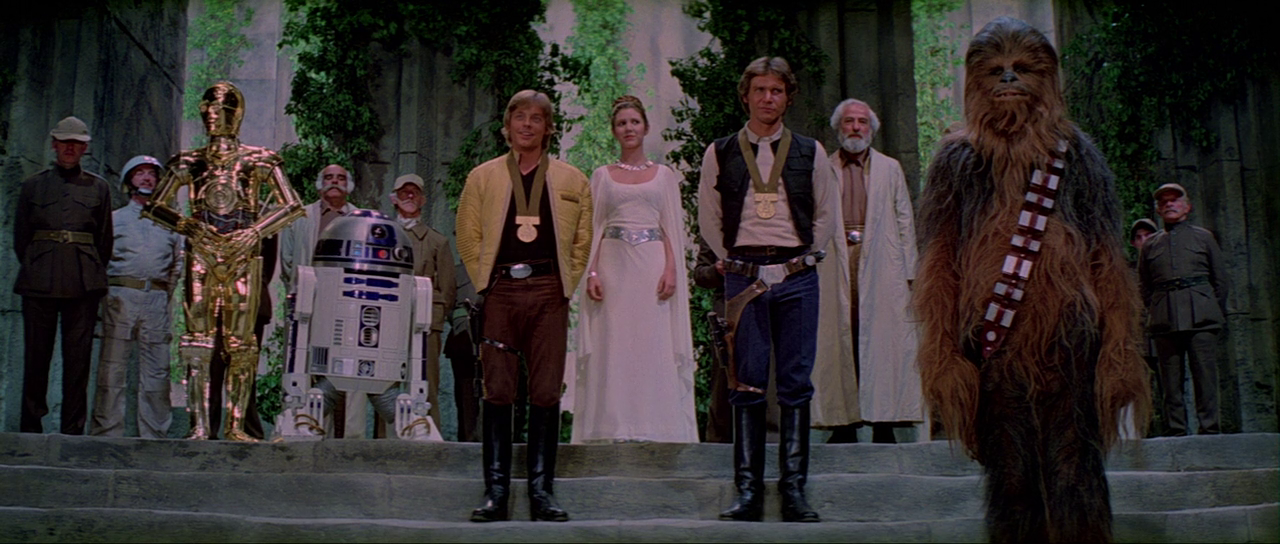
There’s little to complain about otherwise, though. All six films, on some level, gets a massive jump in quality over their DVD counterparts, though anyone who honestly expected all six films in this set to be the be-all, end-all HD experience, given all that’s been done to them through the years, should die screaming in an chemical factory fire on Valentine’s Day temper their expectations some. If you want to get nitpicky, yes, you can play Where’s Waldo with all the swapped-out mattes, the digital enhancements, and random spots of grain where the effects have been cleaned up over the years, and I personally get a kick out of the fact that the picture’s so clear that you can see David Prowse’s eyes through the Vader mask in both New Hope and Empire, but in the moment, stuff like that breezes by without a second thought. The prequels obviously fare better. There’s an intentional softness to Attack of the Clones that keeps it a hair away from the promised land, but even there, that softness, and an insane amount of detail grant the otherwise excremental romance scenes on Naboo a luscious, dreamlike quality that’s worth clicking the mute button for to enjoy in peace. Revenge of the Sith, on the other hand, can take a seat next to Avatar on the high throne of absolutely PERFECT transfers.
4/5
The Sound
While there’s reservations about the video depending on the film, there are zero complaints to be lobbied against the audio. The DTS tracks given each film showcase every last drop of Ben Burtt and John Williams’ efforts, from the infamous Jango Fett seismic depth charge, down to the tiniest whispers of pilot chatter when Leia watches the Death Star trench runs unfold. I think I’m most happy that the audio issues that plagued the OT Star Wars set (i.e. “You would prefer another target? Then name the system!”) are non-existent. Just a completely stellar set of transfers here.
5/5
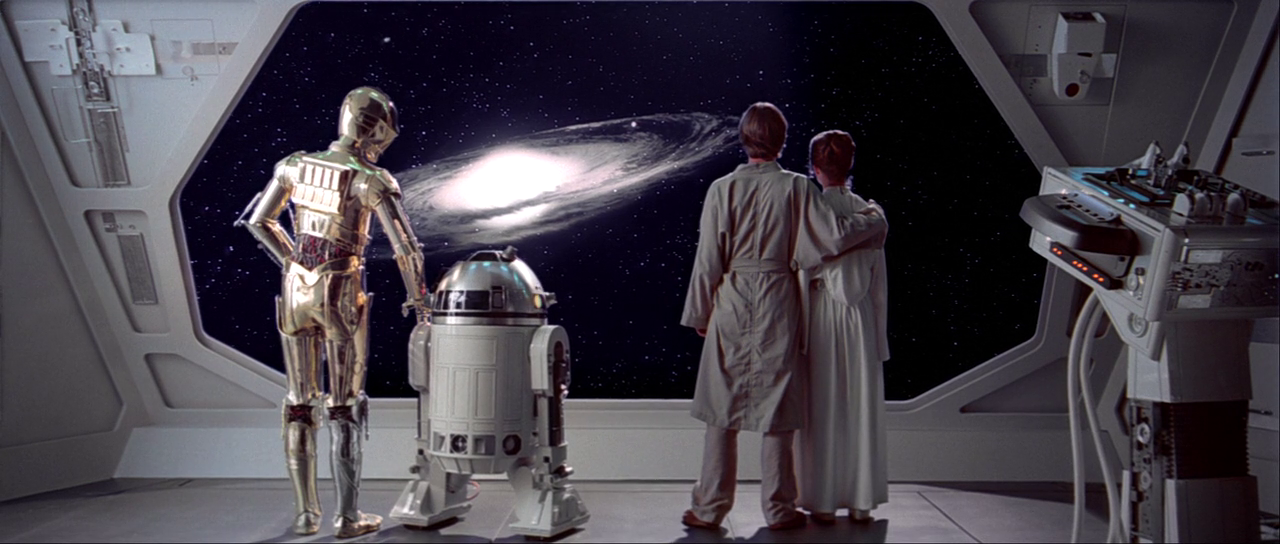
The Bonuses
The menu layout for all the discs feels less appropriate for Star Wars, more appropriate for a Terminator flick (and if you own T2: Skynet Edition, these would be more than welcome as a replacement). They’re easy enough to use, and not so slick as to be cumbersome, even with the flashy transitions. The small touches are also welcome: Every single feature on the bonuses has subtitles, and the longer documentaries on Bonus Disc 3 have handy chapter stops roughly every 15 minutes.
As for the actual content, well, for the OCD among you, there’s good news and bad news: The good news is this is 98% new stuff. The bad news is, commentaries and a few odds and ends (mostly concept artwork) notwithstanding, there’s NOTHING from the previous discs that made the jump to Blu. Not the stellar Episode I The Beginning documentary. Not the deleted scenes. Not the great gag reel easter eggs (except for that awful hip-hop Yoda thing from Sith‘s DVD). Not Empire of Dreams. NOTHING. Completionists: Don’t go selling shit.
The only bonuses on the main film discs are commentaries. Each contains the solid, but slightly over-technical, tracks from the DVDs, and a new track, stitched together from random interviews from just about everybody who even randomly coughed into a microphone during the filming of any of the movies. Surprisingly, the Frankensteined interview tracks are probably the strongest material in the set. It helps from the production side being able to cherry pick information depending on the scene instead of just letting the film play to someone in a booth, but they’re veritable treasure troves of information and anecdotes. I’m partial to the ones on Empire though, only because Irvin Kershner’s one of those voices I’d have paid to read the phone book to me.
The meat of the bonuses spans 3 discs, each film getting its own section for the first two (the prequels on Bonus Disc 1, the OT on Bonus Disc 2), and a collection of new and vintage documentaries on Bonus Disc 3.
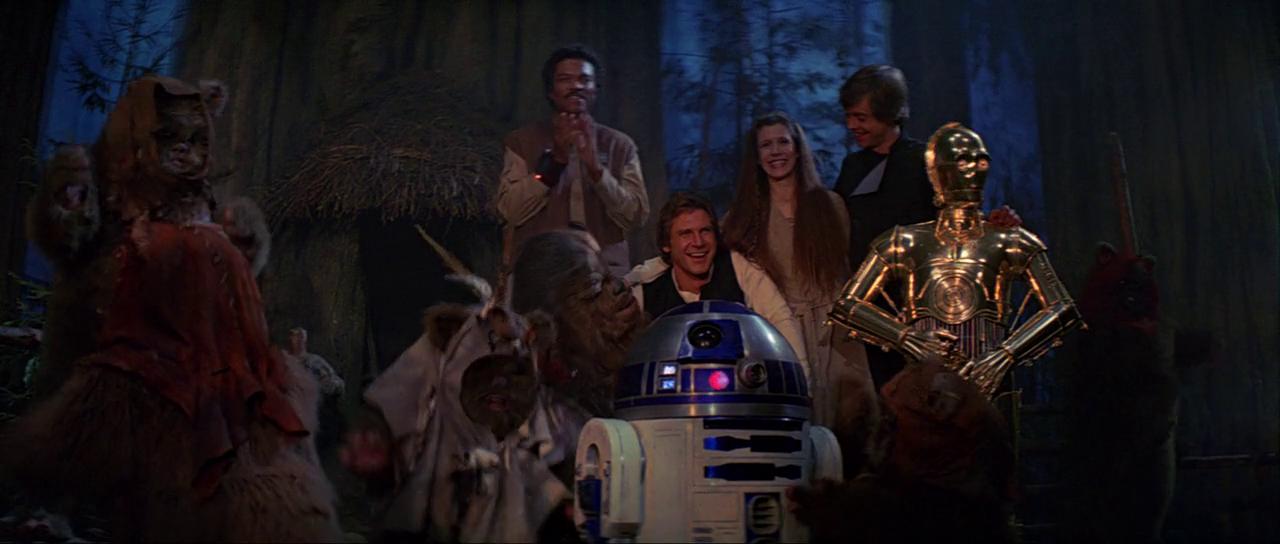
For the first two discs, after picking your episode, you then have the choice of picking your planet, corresponding to all the scenes that take place there. If you want to see all the features about the podrace, you go to Tattooine in Episode I. The Obi-Wan/Anakin Duel, Episode III, Mustafar, and so forth. the first two discs break down into 5 sections under each planet/episode: Interviews, Deleted Scenes, Collections, and Concept Art. The interviews are mostly general rundowns about the design of specific setpieces, and challenges of filming. Again, nothing much in depth, but still a stretch better than your average EPK. Anyone looking for the highlights, I recommend the Geonosis section of Episode II, Samuel L Jackson’s interview, the Order 66 Overview, Mark Hamill’s interview, the Dagobah section on Empire, and the Overview for the Death Star Battle II in Jedi.
For the prequels, sadly, the brunt of the deleted scenes of any real worth are on the original DVDs, but there are morsels of goodness here. Some real gems were cut out of Sith, especially. The stand-out here being an 8-minute animatic Steven Spielberg actually came up with for the Grievous chase on Utapau. It’s insanely long, but there’s some wild moments of genius in there, particularly a bit involving an oncoming train. The OT disc, on the other hand, is a goldmine of lost footage. Stuff fans have only hear rumors about for years (Luke hanging out with Biggs at Tosche Station, his more romantic near kiss with Leia in Empire, building his green lightsaber in Jedi) is all in here, along with a ton of other random scenes. Not all of them are as revelatory as that, but it’s worth checking out if only for posterity. Past that, there’s a 4 minute long flythrough of the Lucasfilm Archives in California, containing just about every reasonably sized prop ever used in a Lucasfilm production. It’s pretty much *the* ultimate nerd shrine to Star Wars, and it’s impossible to not crack a smile at the end of it.
Collections basically gives you a 3D model of ships, characters, and costumes, which is really just good for cosplay purposes. The Concept Art speaks for itself, and again, some of this stuff we have seen before, though I’d highly recommend poking around in there anyway. Especially in Episode V, Pursued By The Empire, under the Boba Fett section. Y’know. For shits and giggles.
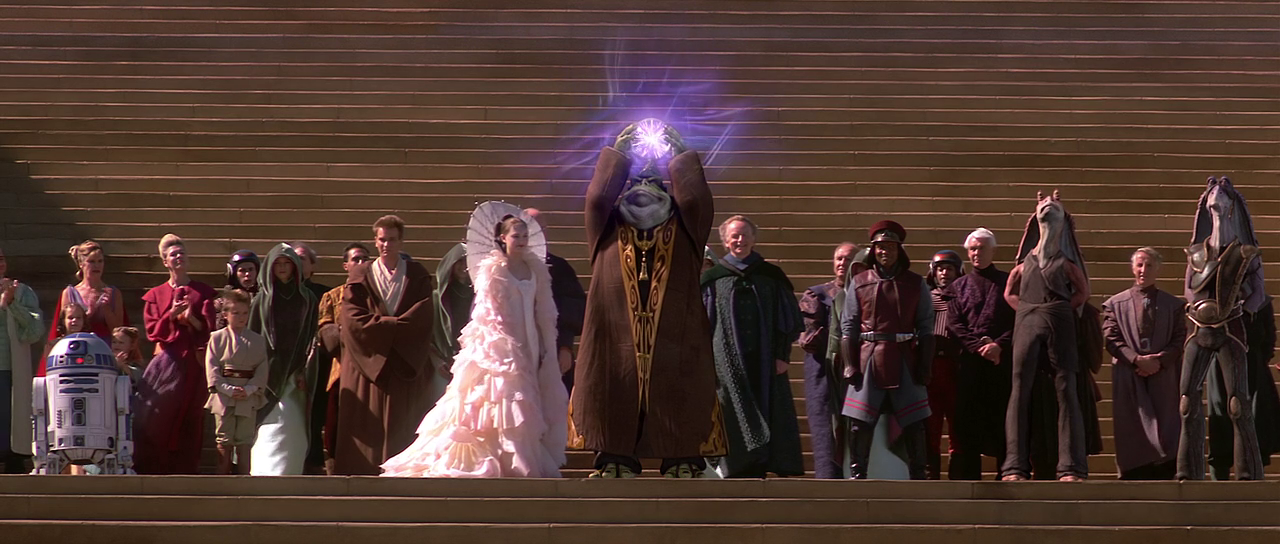
Bonus Disc 3 contains the full documentaries, half old, half new. Despite cheesy frameworks, the vintage docs–The Making of Star Wars, the SP FX Empire documentary, and Classic Creatures: Return of the Jedi–are actually fairly heavy with info, the Star Wars doc more because of some rare behind-the-scenes interviews with Hamill, Fisher, Ford, and Lucas, the Empire and Jedi ones for a surprisingly in-depth look at those two films’ effects work, and terrifying late 70s fashion.
There’s an documentary about the added dewbacks in A New Hope from ’97, and the insane amount of work put in to just getting the added plates to add to this 20 second scene. A week or two before I got to this point in the review, someone on my Facebook (either CHUD’s own Patrick Ripoll or mcnooj) talked about a tidbit from the Ultimate Matrix Collection about how the Wachowskis spent an untold amount of time and money during Revolutions trying to perfect the perfect raindrop, and how that pretty much encapsulates the sequels in a nutshell. This thing about the dewbacks? The worst tendencies of the prequels in a nutshell.
Star Warriors is an interesting, if a bit overlong, documentary about the 501st Legion, probably the biggest organized cosplay group on the planet. They also do a ton of charity work and have a lot more actual military involved getting their marching choreography down, so, if any of you guys are reading? No hard feelings about the preamble, right?
Star Wars Tech is a special produced by the History Channel a couple years back where pre-eminent scientists and physicists stomp on and destroy all your childhood illusions like the assholes they are. Actually, it’s all pretty cool, especially the bit about what Vader’s suit would need to help him survive what happens on Mustafar.
The Conversation With The Masters doc has more of Irvin Kershner talking in what I’m pretty sure is his last interview on camera, but the feature as a whole is a great little behind-the-scenes doc about the making of Empire, with Lucas and John Williams waxing nostalgic, and a surprisingly miniscule amount of overlap from the commentaries.
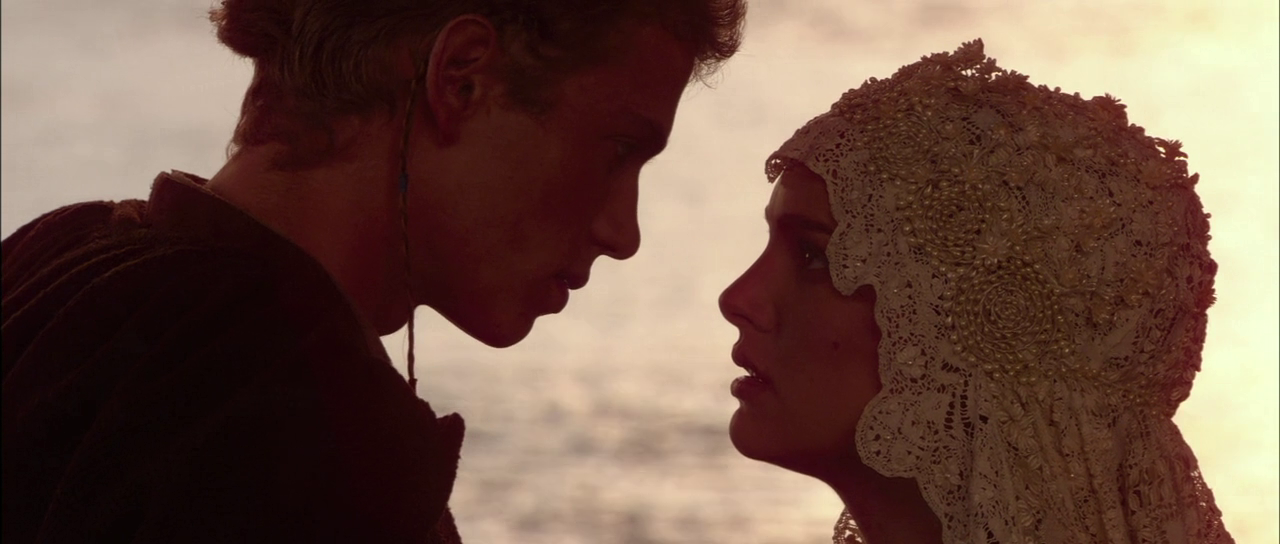
Star Wars Spoofs is exactly what it sounds like: an hour and a half choice collection of Star Wars parodies and references from over the years. The obvious choices are in there from Robot Chicken, Family Guy, That 70s Show, Spaceballs, Clerks and the likes, but there’s also some complete oddities, like a Stormtrooper musical on Donnie and Marie, with Kris Kristofferson as Han Solo. The two highlights are Lego related: A Lego version of Eddie Izzard’s Death Star Cantina bit, and a fancier Lego rundown of the OT, narrated by a 10 year old. The aforementioned Stephen Colbert Green Screen Challenge is in there too, as is the classic Bill Murray lounge version of the Star Wars theme. This is one of those features I wish they’d gotten greedy with the chapter stops, but it’s basically an hour and a half long easter egg.
The question then becomes is the new content worth it? And I’m gonna answer yes, though it’s not an emphatic yes, not the kind of yes I gave when all the appendices carried over to the Lord of the Rings EE Blu Rays. There’s certainly a lot of material, covering a good swath of ground, but not nearly enough to make this any sort of definitive digital compendium of Star Wars. It’s a giant feast made up entirely of tasty hors d’oevres, but no entree.
3.5/5
If you’re buying the set, buy for the films, made up all pretty, shiny, and new, in the best possible format.
And, if you do enjoy these films, for fuck’s sake, enjoy them. Enjoy them for what they are, enjoy them for what you get out of them. Enjoy it with the best TV and sound system your money can buy. Enjoy them with like-minded friends, family, kids. Enjoy the subtext, the worlds, the aliens, whatever it is that gets you off about this silly series of films. And if whatever Lucas does doesn’t jive up with what you love about it, the Star Wars you do love is out there, and nobody has ever taken them away from you. If you love it that much, you’ll do the legwork to find that version and watch it. That’s what fans do. Go to a horror convention sometime, and ask how many of those crazy motherfuckers still own VCRs based on that very principle, and for the love of INFINITELY shittier films than the prequels.
Or don’t. If you made it through all this, I’m assuming some part of you still holds a torch for this series. But not enough to reward Lucas’ tinkerings. Which is fine. Let Star Wars crash and burn in peace. Filmmakers with a far stronger grasp on the human element have made objectively stronger pieces of work over the years, with far fewer zealots for fans. Find your preferred galaxy far, far away elsewhere. Judging from how many of you wouldn’t shut up about the new Song of Ice and Fire book not too long ago, that hasn’t been hard either. This, too, is what good fans do: Never settle.
Both these groups of people have DEPTHS to learn from each other.
After a month of writing, what I learned is that, while it will never, ever be above reproach, I still love a great deal of what Star Wars is, as a series of films. The story being told in both trilogies is one I still enjoy being told to me, even if there are parts that falter. Nothing that George Lucas or his fans, current and former, have done to them thus far has changed that. The films on these discs remain a version of Star Wars worth appreciating, and the features add just a few more levels to that. The important part, for me, is that I love Star Wars enough that I can discuss everything right about it, everything wrong about it, and then, when its over, for the good of everyone, shut the fuck up about it.
Like, now.
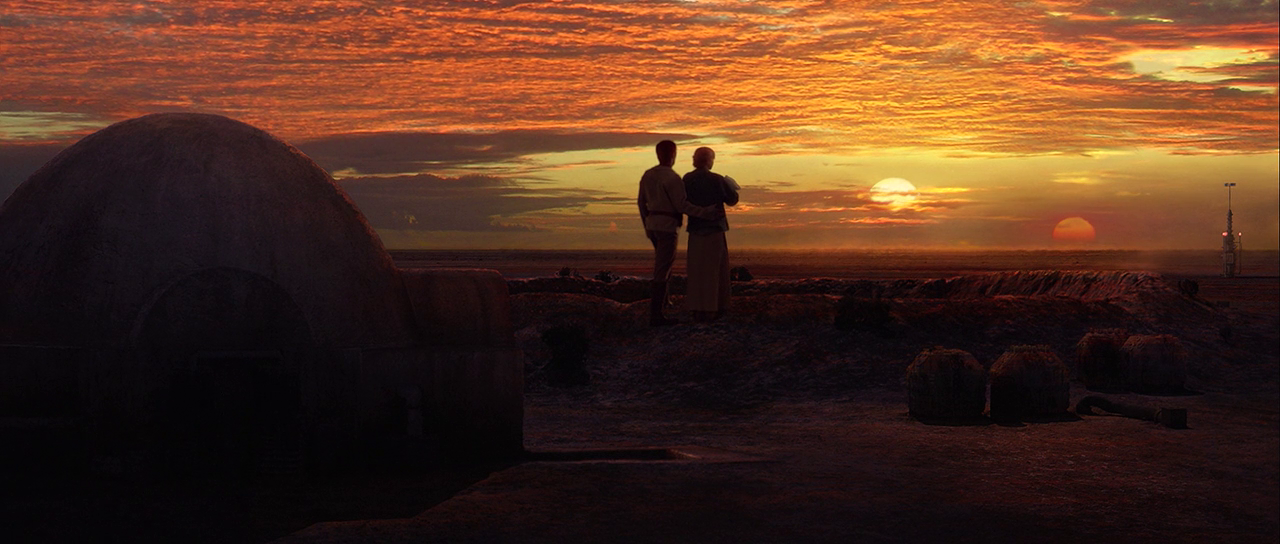




out of a possible 5
